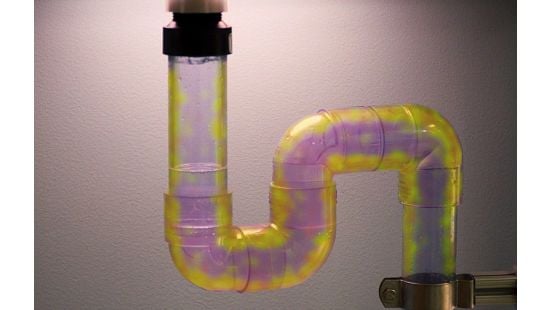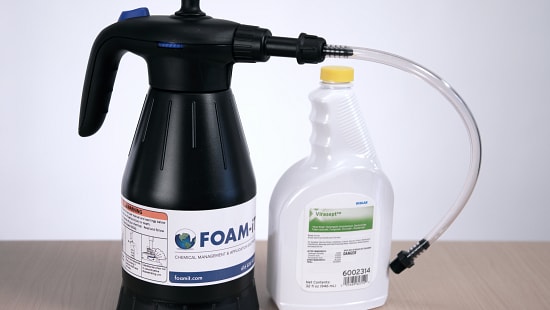Healthcare Drains as a Hidden Healthcare-Associated Infection (HAI) Reservoir
Challenges and a New Solution

Background
Published literature reviews provide evidence that sink, shower and other wastewater drains in healthcare settings have been associated with outbreaks, particularly among the most vulnerable patient populations in neonatal and adult intensive care units, burn units, transplant units and hematology/oncology units. These outbreaks are difficult to recognize and manage because long intervals of time may pass between cases, and the number of cases at any given time is low. Once an outbreak is identified, it can be challenging to eliminate one of the increasingly recognized sources – bacteria growing in biofilms in drains.
Waterborne bacteria are the predominant organisms found in sink-related outbreaks with the most common organism being Pseudomonas aeruginosa. Other pathogens include Enterobacteriaceae, such as Escherichia coli, Klebsiella pneumoniae, Klebsiella oxytoca, Serratia marcescens, Enterobacter species, and Citrobacter species. Multidrug-resistant strains of these organisms are commonly found, with carbapenemase resistance most frequently identified. Enterobacteriaceae producing extended-spectrum beta-lactamases (ESBLs) as well as multidrug-resistant P. aeruginosa and A. baumanii are also commonly identified. The true burden of sink-related infections is likely underestimated as there is currently no widespread systematic strategy to identify and track this type of healthcare-associated infection.3 Furthermore, previously identified methods to disinfect drains such as pouring disinfectants down the drain, applying pressurized steam, or replacement of sink plumbing have had very limited success.1,2
Immunocompromised patients are most susceptible to infections with these organisms.1 In a review of four studies, Kizny-Gordon et al. found that risk factors for wastewater drain-associated colonization or infection are: preceding surgery, patient location, prolonged mechanical ventilation, older age, burns, longer hospital stay, and drinking tea from a contaminated dispenser.2 Almost all identified outbreaks have occurred in ICUs and hematology-oncology units.
How Does the Bacteria in Drains Spread?
Parkes et al reviewed the risk mitigation strategies for sink related outbreaks between 2012-2018, discussed here.3
- Sink and faucet configurations may contribute to bacterial transmission. Faucets flowing directly into drains and shallow sink basins have been shown to cause splash-back. This can contaminate the hands of healthcare workers or patient care items that are stored adjacent to the sink. In addition, sinks are often used to dispose of fluids and materials other than water. These non-water substances can provide nutrients to encourage bacterial biofilm growth.
- Hospitals often have aging and modified water systems with uneven temperature control and dead-end pipes. Temperature fluctuations and stagnant water can contribute to bacterial growth in hospital tap water.
- Below the drain, plumbing issues may also exist such as scale build up or p-traps and piping made of materials that encourage biofilm growth.
- Existing drain disinfection chemistries and technologies are not effective at killing bacteria in drains. Efforts to disinfect drains have included complete replacement of the sink or its components, installing self-cleaning traps, disinfection with processed steam, enhanced manual cleaning, descaling of pipes, and disinfection with chlorine-based solutions or other liquid disinfectants. It’s important to note that liquid disinfectants do not come in contact with the surface of the drain long enough to meet the contact time needed to kill the bacteria.4
How Can I Prevent Spread?
Existing methods to react to drain-associated outbreaks have been “woefully ineffective” at eliminating sink colonization.
Parkes et al suggest a more proactive approach including optimizing best practices in sink design and placement and healthcare worker behavior to prevent transmission.
- Correct defective conditions in water systems such as dead ends, low water use areas, temperature and pressure fluctuations
- Ensure that faucets don’t flow directly into the drain to minimize splashing/aerosolizing
- Consider changing to deeper sink basins to prevent cross-contamination of hands and adjacent surfaces
- Eliminate misuse of sinks to dispose of fluids and materials that can provide nutrition for bacterial biofilm growth
- Ensure that patient care items are not stored adjacent to sinks to avoid cross-contamination
- Ensure that p-trap and piping are made of materials recommended by national and state plumbing codes
- Consider replacing sinks or affected components to remove source of transmission. Note that replacing sinks may solve the problem temporarily, but eventually biofilm will grow in the new sink.
Various methods of cleaning and disinfecting drains have been tried with mixed results. They sometimes end the outbreak, but do not provide sustained decolonization of sinks; however, new research suggests that implementing a routine drain disinfection program with a product that kills bacteria in biofilm, can maintain proper contact time for the product to take effect, and can be easily applied on a routine schedule may provide sustained decolonization of the sink drain, thereby preventing transmission of potentially dangerous pathogens from sinks.
Virasept™ Foaming Application
Ecolab’s patented, peracid mixture, ready-to-use cleaner, deodorizer and hospital disinfectant is an all-in-one sporicide, virucide, bactericide, tuberculocide and fungicide. ViraseptTM (EPA Reg. No. 1677-226) is effective against a broad spectrum of organisms, including Clostridiodes difficile, endospores, Candida auris*, Legionella pneumophilia*, and Listeria monocytogenes* and several other tough-to-control pathogens. It is also included on the Environmental Protection Agency’s (EPA) List N: Disinfectants for Use Against SARS-CoV-2.**
When launched in 2010, Virasept was the first ready-to-use C. difficile sporicidal product on the market. Now, Virasept is again the first-to-market by demonstrating effectiveness against Staphylococcus aureus and Pseudomonas aeruginosa biofilms when applied as a foam to wastewater drains.* Bringing decades of expertise in infection prevention, the Ecolab team worked together with the EPA to refine the test methods required to show foaming efficacy against these pathogens in drain biofilms. The unique foaming application allows the disinfectant to remain in contact with the vertical surfaces of the drain long enough to kill bacteria in biofilms. A clinical study has shown that a treatment program at scientifically driven intervals can effectively manage biofilm in wastewater drains.5
Studies that Support Virasept for Drain Biofilm Disinfection
A study was conducted in patient rooms in a MICU in a 565-bed teaching hospital to compare the efficacy of Virasept to another hydrogen peroxide-based disinfectant (Peroxide Multi Surface Cleaner, Ecolab, Inc.) at reducing bacteria in hospital sink drains.5 The study also sought to determine the ideal frequency of sink drain disinfection. Sinks next to the toilet in a patient room were evaluated in this study. Twenty-six sinks were randomized to receive one of the two foaming products or act as a control. Daily and terminal cleaning practices and products remained unchanged during the study. Sink drains were sampled on days 1, 3, 5 and 7 after the foam interventions, and samples were processed in the microbiology laboratory. On day 1 (day after application), a significant reduction in bacteria (11.95 CFU/mL to 2.01 CFU/mL) was observed in the drains treated by Virasept, with gradual regrowth over five days.
Importantly, based on the reduction and gradual regrowth of bacteria in the tested drains, they recommend applying Virasept every 3-5 days in settings where there is concern that sink drains may be reservoirs for resistant pathogens.
In addition to demonstrating efficacy, Ramos concluded Virasept was “relatively affordable”, required a maximum of 30 seconds to apply per sink, was easy to use and dispense, and created minimal odor.
Another study compared several liquid and foam drain disinfection methods, including Virasept, in patient rooms in a hospital and affiliated long-term care facility.4 First, they compared the efficacy of a single treatment of four different products applied as a foam in reducing gram-negative bacilli in the sink drain. Virasept was significantly more effective than the other three products. Foam versus liquid disinfectant was then compared using Virasept foamed into the drain compared to liquid hydrogen peroxide/peracetic acid liquid disinfectant (OxyCide) poured into the drain. Virasept foam significantly reduced recovery of gram-negative bacilli on days 1, 2, and 3 after treatment, with a return to baseline by day 7. Finally, the effectiveness of repeated treatments with Virasept every 3 days was evaluated. With repeated treatments, Virasept produced a progressive decrease in bacterial load recovered from sink drains.
The study concluded that Virasept is an easy-to-use application that suppressed sink drain colonization for at least 3 days. They further concluded that intermittent application of Virasept could potentially reduce the risk for dissemination of pathogens from sink drains.
In summary, outbreaks associated with multidrug-resistant organisms in wastewater drains have been increasingly recognized in the past decade.1,2,3 Immunocompromised patients are most susceptible and almost all identified outbreaks have occurred in ICUs and hematology-oncology units.1 Outbreaks associated with wastewater drains are difficult to recognize because common surveillance methods don’t consider the drain as a source.1 In outbreak settings, most wastewater drains were colonized with the organism strain associated with the outbreak.1 The process of drain disinfection is challenging because drains are not amenable to standard cleaning and disinfection products and practices. Previously available drain disinfection protocols have had limited, if any, impact on drain system colonization.3,4 Use of foam disinfectants at scientifically defined intervals could provide a simple and practical alternative to other approaches for reducing sink drain colonization.4 In clinical studies, Virasept was more effective in reducing sink drain colonization than 3 other foam products4 and foam application of Virasept was effective in suppressing proximal sink drain colonization for at least 3 days.4 Due to the effectiveness, relative affordability and easiness of application, regular application (every 3-5 days) of a mixture of hydrogen peroxide, octanoic acid, and peroxyacetic acid foam (Virasept) should be considered in settings where there is concern that sink drains are acting as reservoirs of resistant pathogens.5
References:
1. Carling PC. Wastewater drains: epidemiology and interventions in 23 carbapenem-resistant organism outbreaks. Infect Control Hosp Epidemiol. 2018;39(8):972-979.
2. Kizny Gordon AE, Mathers AJ, Cheong EYL et al. Carbapenem-resistant organisms causing hospital-acquired infections: A systematic review of the literature. Clin Infect Dis. 2017;64:1435-1444.
3. Parkes LO, Hota SS. Sink-related outbreaks and mitigation strategies in healthcare facilities. Current Infectious Disease Reports. 2018;20:42.
4. Jones, LD, Mana TSC, Cadnum JL, Jencson AL, Silva SY, Wilson BM, Donskey CJ. Effectiveness of foam disinfectants in reducing sink-drain gram-negative bacterial colonization. Infect Control Hosp Epidemiol. 2020;41:280-285.
5. Ramos-Castaneda JA, Faron ML, Hyke J et al. How frequently should sink drains be disinfected? Infect Control Hosp Epidemiol. 2020:1-3.
*These claims are pending approval in some states at the time of publishing (11/16/20). Please check with your local account executive for updated information.
**Virasept has demonstrated effectiveness against viruses similar to SARS-CoV-2 on hard non-porous surfaces. Therefore, this can be used against SARS-CoV-2 when used in accordance with the directions for use against *Norovirus at a 4 minute contact time on hard non-porous surfaces. Refer to the CDC website at cdc.gov/coronavirus for additional information.




